HyFlex (Hybrid-Flexible) courses offer immense potential to attract a growing student population: non-traditional students. Non-traditional learners, who are often working or raising families, prize flexibility and choice—two distinctive attributes of HyFlex.
Nearly 40% of U.S. college students are considered non-traditional, a percentage only expected to grow in the era of the Great Resignation. How can schools leverage HyFlex courses to recruit this growing population? We’ve created this guide to help.
What are HyFlex courses?
HyFlex courses fuse in-person and online learning—both live-streamed and recorded. Each class is offered in-person, synchronously (live) online, and asynchronously (recorded) online. Students can choose their preferred format for each class session.
According to Educause, the HyFlex model’s customizable format helps increase accessibility—a benefit that can also grow enrollments.
By offering equitable access and experiences, HyFlex can reduce barriers to enrollment and enable more students to achieve their educational goals
Additional benefits include:
- Scheduling flexibility
- Technology education
- Personalized school—life integration
How do you identify a non-traditional student?
According to the Association of American Colleges & Universities, non-traditional students are 25+ years with one or more of the following life circumstances:
- Cares for dependents
- Employed full-time
- Enrolled in school part-time
- Financially independent
- Single parent
- No high school diploma
Non-traditional learners typically enroll for career advancement and are likely to attend a 2-year vocational school or community college. First-generation students are also considered non-traditional.
Barriers to enrollment
Time and cost are top enrollment barriers for non-traditional students, per a study by Western Governor’s University. Hanover Research also provides a helpful framework for understanding challenges.
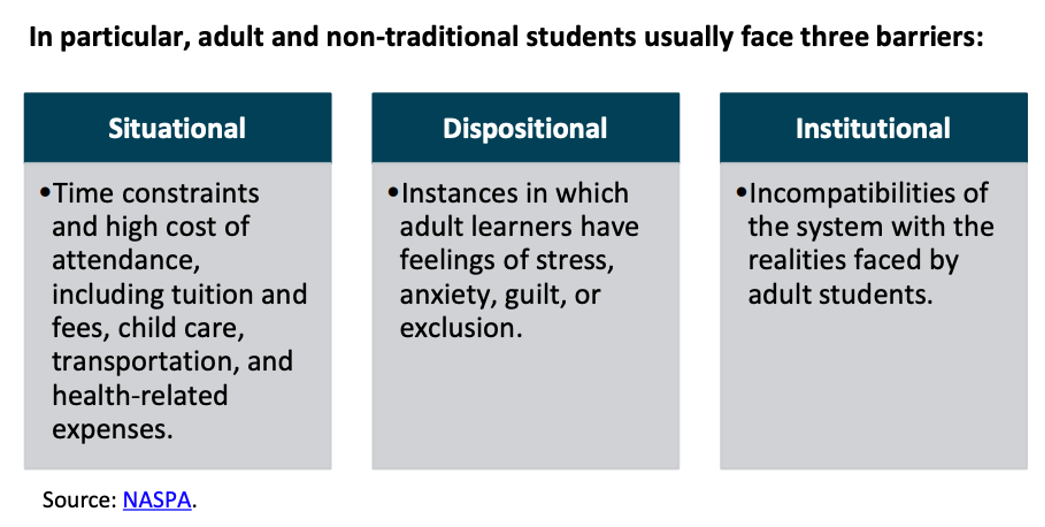
Other barriers might include:
- Work-study-life balance
- Emotional challenges, such as lack of self-confidence
- Perceived lack of on-campus support services
For additional insights into non-traditional students, check out our recent blog post, How to Address the Struggles of Non-Traditional Students.
Strategies for marketing HyFlex courses to non-traditional students
Effective marketing campaigns typically address student challenges and needs. When marketing HyFlex courses, consider the following approaches.
1. Emphasize flexibility
Non-traditional learners want to know how their studies will complement their existing commitments. Many are busy raising families or working full-time. Coursework flexibility is key.
HyFlex courses can be flexible in multiple ways, including:
- Modality (online versus in-person)
- Timeline for completion
- Financing
- Faculty availability
- Overall program flexibility
Consider highlighting different aspects of flexibility in your marketing materials. Student testimonials can be an especially effective tool, as testimonials illustrate personal impact and outcome.
Champlain College does a great job of showcasing the online, non-traditional student experience using testimonials.
Champlain features different nontraditional students’ success stories emphasizing the program’s flexible format.
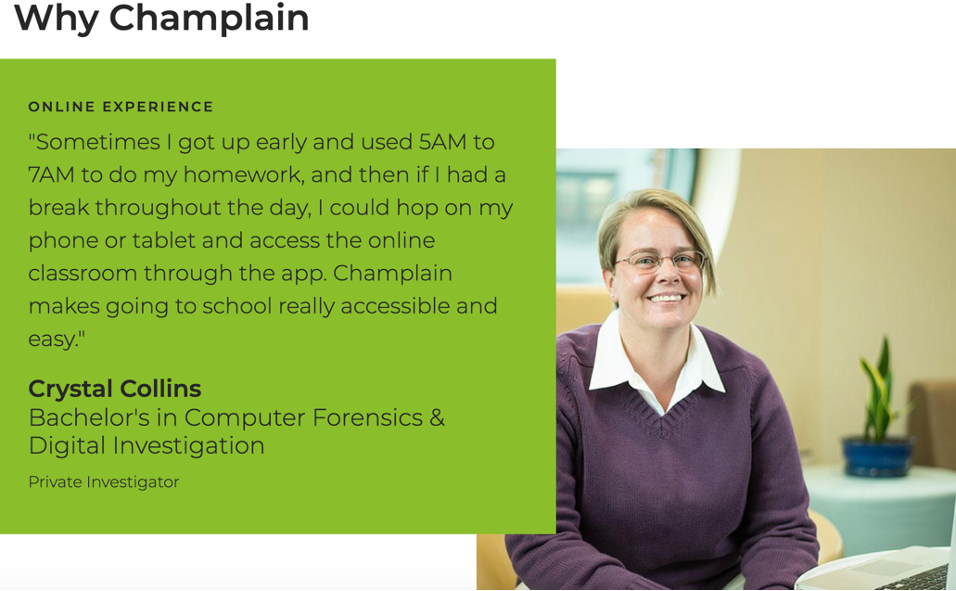
Champlain also reimagines individual testimonials from the video as graphics. Crystal’s selected quote emphasizes the program’s accessible and flexible format.
Even Champlain’s web page emphasizes flexibility by discussing program technology, scheduling, and financing. Even the URL exudes flexibility: online.champlain.edu/experience/school-life-balance.
2. Highlight successful outcomes
Non-traditional learners tend to enroll primarily for career advancement. Illustrating successful professional and personal outcomes is key.
They’re not only vetting your program; they’re vetting your competitor’s programs. Adult learners are smart and are looking for ROI—just like marketers.
Davia Lassiter, director of marketing at Kennesaw State University’s College of Continuing and Professional Education
Consider demonstrating successful student outcomes by:
- Integrating career stats into messages
- Illustrating skills and training students will receive
- Publishing alumni success stories
- Posting career outcomes on website
Check out the career outlook webpage by Western Governor’s University (WGU), an online college in Utah.
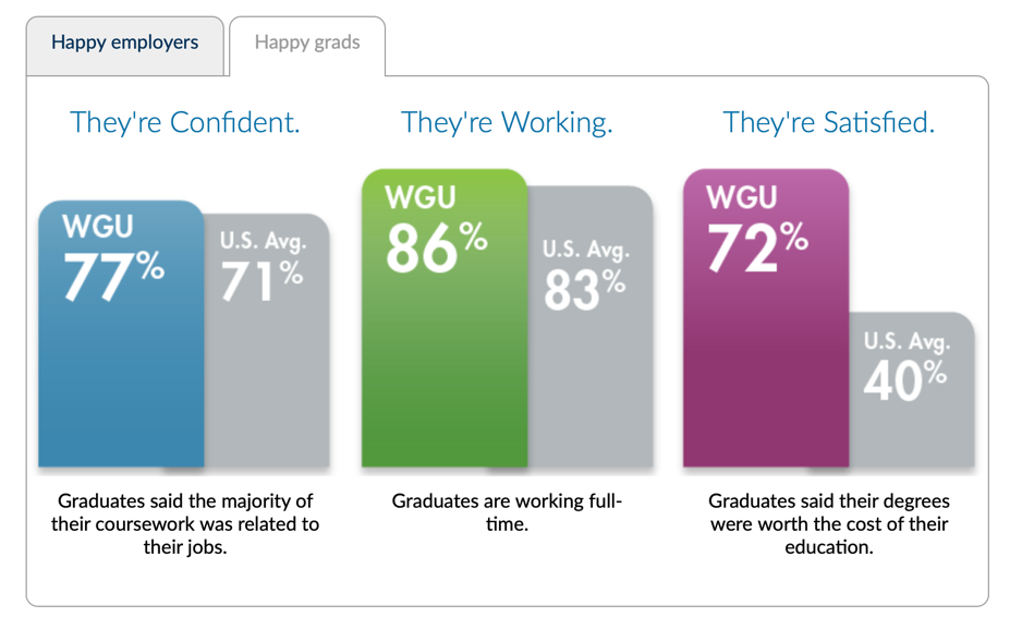
WGU illustrates three key alumni outcomes compared to the U.S. average. WGU also provides employer outcomes under the “Happy employers” tab
The digital ad campaign below from Southern New Hampshire University (SNHU) is also an interesting outcomes-driven approach.
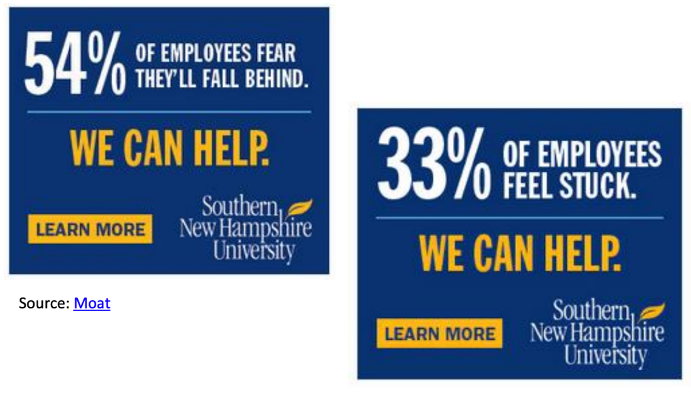
SNHU targets adult workers in full-time jobs who may be seeking alternative career options. The school draws a direct connection between prospect concerns and SHNU as a solution. The emotional appeal of the ads is also compelling.
3. Highlight affordability and aid options
Finances are top-of-mind for non-traditional students. According to Barnes & Noble College, only 15% of adult students feel financially secure—a challenge that often deters enrollment and graduation.
To mitigate financial concerns, consider emphasizing affordability and providing detailed financial aid information. Offer financial tools and resources as well, such as financial counseling information.
Content might include details on:
- Tuition and fees, per course and program
- Scholarships and grants
- Loan options
- Transferable credits
- Typical class schedules
- Program length
Gene Juarez Academy, a beauty school in Seattle, structures their financial aid information.
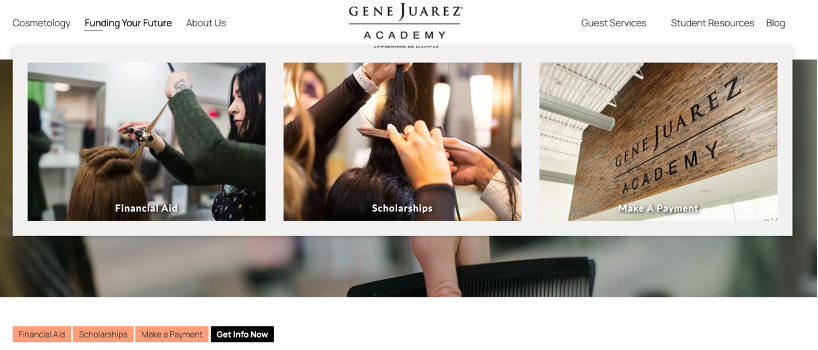
Gene Juarez features a “Funding Your Future” tab on the homepage, which includes separate pages on financial aid, scholarships and tuition payment for current students. The scholarships page is particularly robust, listing 10 different options with funding amounts and deadlines.
Gene Juarez also features a net price calculator to give applicants a sense of what other students pay.
4. Promote support services
Non-traditional learners—especially those primarily online—often aren’t aware of support services like career counseling. For prospects, extracurricular services can be especially important in fostering a sense of belonging and support.
Consider promoting tailored services for HyFlex students. Strategies might include:
- Highlighting career and financial services in program brochures
- Publishing stories illustrating impact of support services
- Linking to services on HyFlex course pages
Check out how Business@American, American University’s online business school, lays out support options on its website.
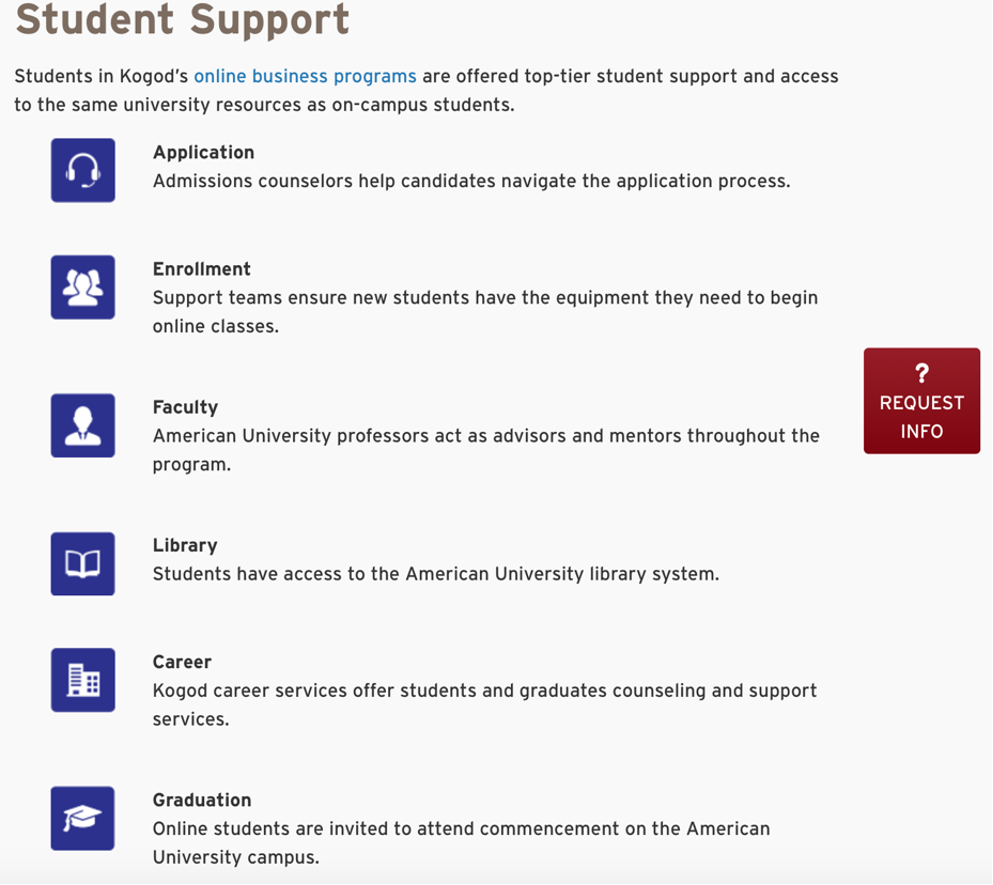
5. Get emotional
Many non-traditional learners enter school with more apprehension and anxiety than traditional students. According to New Directions for Student Services, prospects often display a “lack of self-confidence” due to negative past academic experiences and concerns for the future.
Schools should acknowledge emotional concerns in messaging and materials. When marketing HyFlex courses, consider the following:
- Take a warm, friendly, and inviting tone
- Use CTAs to push for personal interactions with staff
- Provide multiple engagement options (email, phone, in-person)
- Offer low-stakes entry points, like free group info sessions
University of Massachusetts Global, which offers HyFlex, online and in-person courses, does a good job of empathizing with students in their messaging.

UMass immediately identifies with students’ busy lives and schedules. The school positions itself as a solution by emphasizing student support.
6. Segment your audience
After testing general messaging, consider segmenting your audience for a more personalized approach.
Non-traditional students can be comprised of many different audiences. Groups interested in HyFlex courses might include:
- Military service members
- First generation students
- Single mothers
- Students aged 65+
- Full-time workers
Once you’ve selected your group, determine the value proposition: What matters most to the audience? Each value proposition differs depending on audience needs and will serve as the bedrock of your messaging.
Take the University of Maryland Global Campus, known for hybrid courses and programs for active service members. Active service members value a particularly high degree of flexibility and mobility, which UMGC outlines on its website:
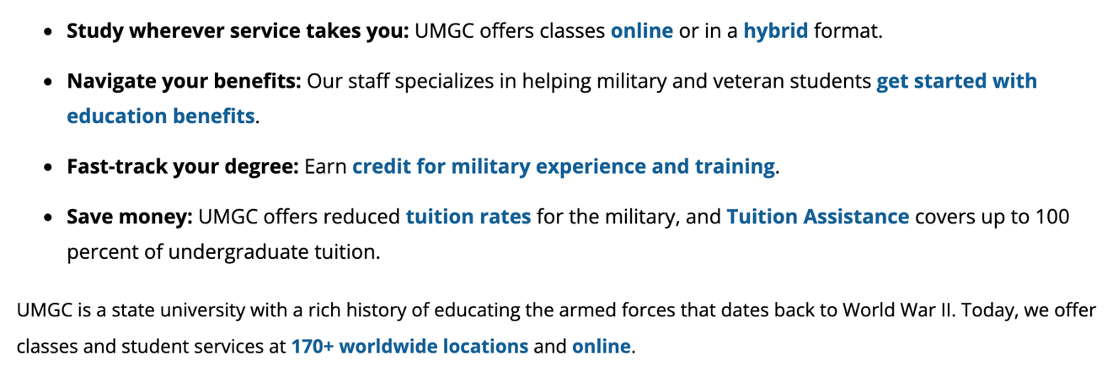
UMGC outlines how hybrid and online classes are flexible, affordable, and efficient—three components servicemembers value. The school also positions itself as an expert by emphasizing its history of running programs for the armed forces.
7. Fine-tune your strategy
Use career-centered imagery
Nontraditional learners typically prioritize career advancement above all else. Try using photos of prospects active in their career fields, rather than in the classroom. Career-centered imagery can help prospects visualize successful outcomes.
Go grassroots
Adult students tend to rely on family, friends and colleagues as top information sources. Consider partnering with local community groups, centers and clubs to expand outreach and form more personal connections with prospects.
Communicate directly
Non-traditional students are often short on time and high on responsibility. Prospects prefer information presented clearly and directly. Consider conducting a website audit to ensure clear communication design, and including a standardized FAQ page.
HyFlex courses—and non-traditional students—are now an essential part of the higher education landscape. By positioning HyFlex courses as a “unicorn” solution for adult learners, your school can leverage this growing population to boost enrollments, for HyFlex programs and beyond.








